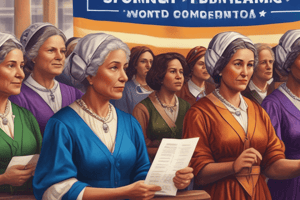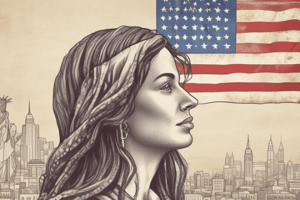Podcast
Questions and Answers
What was the main focus of the Seneca Falls Convention?
What was the main focus of the Seneca Falls Convention?
- Addressing women's rights (correct)
- Discussing economic reforms
- Promoting racial equality
- Advocating for educational rights
How many people approximately attended the Seneca Falls Convention?
How many people approximately attended the Seneca Falls Convention?
- 200
- 500
- 1000
- 300 (correct)
What was the key document drafted just before the Seneca Falls Convention?
What was the key document drafted just before the Seneca Falls Convention?
- Declaration of Sentiments (correct)
- Emancipation Proclamation
- Bill of Rights
- Magna Carta
What was the major goal of the Women's Movement as outlined in the Declaration of Sentiments?
What was the major goal of the Women's Movement as outlined in the Declaration of Sentiments?
What was the eventual outcome of the Women's Movement, also known as the First Wave of Feminism?
What was the eventual outcome of the Women's Movement, also known as the First Wave of Feminism?
What did the Women's Movement fight to better in the lives of women?
What did the Women's Movement fight to better in the lives of women?
What was the Women's Movement sometimes called?
What was the Women's Movement sometimes called?
Who were the main organizers of the Seneca Falls Convention?
Who were the main organizers of the Seneca Falls Convention?
What did the Seneca Falls Convention result in the adoption of?
What did the Seneca Falls Convention result in the adoption of?
Which amendment granted women the right to vote?
Which amendment granted women the right to vote?
Who was an anti-slavery activist and advocate for women's rights present at the convention?
Who was an anti-slavery activist and advocate for women's rights present at the convention?
Where was the Seneca Falls Convention held?
Where was the Seneca Falls Convention held?
What did the passage of the 19th Amendment lead to?
What did the passage of the 19th Amendment lead to?
What was the main focus of the second wave of feminism in the 1960s?
What was the main focus of the second wave of feminism in the 1960s?
Who co-founded the women's rights newspaper The Revolution?
Who co-founded the women's rights newspaper The Revolution?
Flashcards are hidden until you start studying
Study Notes
Seneca Falls Convention and the Early Women's Movement
- The Seneca Falls Convention was the first women's rights convention in the United States, held in 1848, and marked the beginning of the early Women's Movement.
- The convention focused on demanding specific rights for women, including property, profession, and voting rights, and resulted in the adoption of the Declaration of Sentiments, which directed the Women's Movement from then on.
- The convention had both collaboration and tension between proponents of abolition of slavery and expansion of women's rights, with some feeling the two issues were intertwined and others believing one needed to be solved before the other.
- The main organizers of the convention were Elizabeth Cady Stanton and Lucretia Mott, who were also active in the abolitionist movement and became leading figures in the Women's Movement.
- Other key players at the convention included Frederick Douglass, an anti-slavery activist and advocate for women's rights, and Mary M'Clintock, who was dedicated to women's equality and the abolition of slavery.
- The early Women's Movement, sparked by the Seneca Falls Convention, culminated in the passage of the 19th Amendment in 1918, granting women the right to vote.
- After the passage of the 19th Amendment, the Women's Movement lost momentum but resurged with the second wave of feminism in the 1960s, focusing on issues beyond voting rights.
- The Seneca Falls Convention was held at the Wesleyan Chapel in Seneca Falls, New York, and consisted of six sessions of lectures, debates, discussions, and presentations of documents.
- The convention was significant as it spearheaded a decades-long movement that resulted in several important advances in women's rights, ultimately leading to the 19th Amendment.
- Elizabeth Cady Stanton was a leading activist in the Women's Movement, advocating for women's right to vote, property rights, and legal rights for women, and co-founding the women's rights newspaper The Revolution.
- Lucretia Mott, also a key organizer, was a Quaker and Minister in the Society of Friends, using her speech-giving skills and biblical arguments to advocate for women's rights.
- The Seneca Falls Convention was a turning point in history, symbolizing the beginning of a long struggle for gender equality and paving the way for future social movements.
Studying That Suits You
Use AI to generate personalized quizzes and flashcards to suit your learning preferences.




